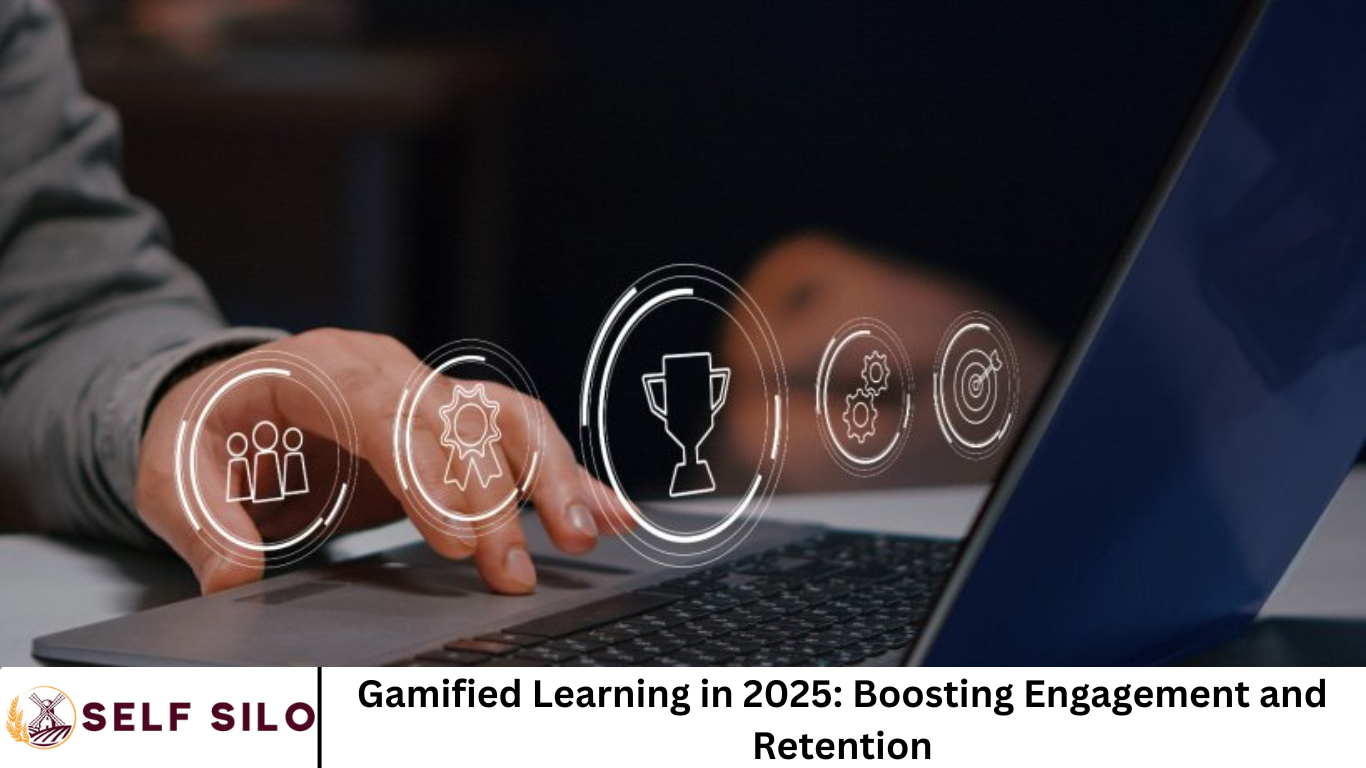In 2025, educators, corporate trainers, and EdTech innovators are turning to gamified learning as a powerful way to enhance engagement, motivation, and—most importantly—retention. With shifts toward digital classrooms, hybrid workplaces, and AI-driven experiences, gamification remains a critical lever in transforming passive instruction into immersive, active learning.
More Read: Blended Learning Approaches: Merging Digital and Face-to-Face Training
Gamification vs. Game‑Based Learning: What’s the Difference?
Before diving deeper, let’s clarify two often‑confused terms:
🎯 Gamification
- Definition: The application of game design elements—points, badges, leaderboards, progress bars, and challenges—to non‑game contexts.
- Use Case: Adds engagement layers to traditional learning (e.g., awarding badges for completing lessons).
🕹️ Game‑Based Learning
- Definition: Using full-fledged games where the content and gameplay are inseparable—learning happens by playing .
- Use Case: Simulations that teach medical diagnostics, coding games, or VR-driven chemistry labs.
Key Differences:
- Goal: Gamification enhances engagement in existing courses; game-based learning teaches through interactive gameplay.
- Resource Needs: Gamification is lighter and quicker to implement; game‑based learning requires higher investment—time, budget, tech.
- Motivation: Gamification can rely on extrinsic rewards, while game‑based learning aims to tap.
Why Gamification Works: Learning Psychology Behind It
Several psychological and educational theories demonstrate why gamification boosts engagement and retention:
Self‑Determination Theory
Game elements satisfy autonomy, competence, and relatedness, fostering intrinsic motivation.
Operant Conditioning
Rewards (points, badges) reinforce positive behavior—learners repeat what’s rewarded.
Cognitive Load Theory
Breaking complex information into smaller, game-like tasks eases cognitive load and aids memory.
Neuroscience Insight: Game elements trigger dopamine release, enhancing motivation and information retention by up to 65% or more .
Core Game Mechanics in Learner Experience
Here are the most common gamified elements:
- Points & XP: Indicate progress and performance.
- Badges & Certifications: Validate accomplishments and milestones.
- Leaderboards: Fuel competition and social motivation—but can demotivate those far behind.
- Progress Bars: Visual motivators showing percentage completed .
- Levels & Challenges: Structured difficulties to foster mastery.
- Narratives & Quests: Contextual storytelling to make learning meaningful.
Reward Systems: Fueling Motivation & Retention
Well-designed reward systems are at the heart of effective gamification:
📌 Virtual Rewards
- Badges and certificates act as social signals and milestone.
- XP and progress bars provide immediate, visible feedback .
📌 Real‑World Incentives
- Company programs award vouchers or perks (e.g., Starbucks stars, YuLife vouchers.
- AI-enhanced loyalty schemes can offer personalized offers and dynamic incentives .
Cutting‑Edge Tools & Platforms in 2025
AI‑Powered Gamification
LLMs and predictive analytics tailor game elements to learner behavior for personalized engagement.
Adaptive Game-Based Systems
Learning platforms that adjust difficulty dynamically, ensuring challenge and progression .
VR/AR Immersion
Virtual labs, historical roleplays, and medical simulations offer deep, experiential learning .
Blockchain Credentials
Digital badges tied to blockchain ensure tamper-proof certification and enhance employability .
Analytics with Feedback Loops
Gamified dashboards with behavioral analysis enable continuous design improvement .
Real‑World Applications: From Classroom to Corporate
🎓 Higher Education
- Quizzes with leaderboards increase class participation.
- Simulation games enhance medical, engineering, and social science training .
🏢 Corporate Training
- Platforms like Kahoot!, 15Five, and Trello use leaderboards and continuous feedback.
- Starbucks leverages gamified loyalty for customer engagement — modeling similar strategies in staff training.
- Duolingo exemplifies gamified employee skill development ? over 500M users globally.
🏥 Healthcare & Training
- Simulated patient diagnosis games enhance clinician proficiency.
- VR software enables repeated and safe procedural training .
Risks, Challenges & Ethical Considerations
The Novelty Effect
Engagement spikes with novelty, dips after a few weeks—but with careful design, familiarization can restore motivation.
Overemphasis on Extrinsic Rewards
Reliance on points and badges can undermine intrinsic learning motivation .
Negative Effects
Leaderboards may demotivate lower performers; badge chasing can bypass deeper learning; cheating can occur.
Bias & Accessibility
Gamification benefits certain learner profiles; less motivated individuals might be left behind .
Privacy & Data Ethics
Tracking behaviors, health, or performance (as in workplace wellness programs) raises data privacy concerns and workplace pressure.
Best Practices: Designing Sustainable Gamification
- Blend extrinsic and intrinsic motivators
Storytelling, meaningful challenges, purpose, social collaboration along with rewards. - Personalize experience
Use AI to match dynamics to individual profiles—interest, skill, pace, culture . - Focus on mastery & flow
Scaffold difficulty and optimize challenge to avoid boredom and overwhelm . - Use analytics
Track engagement metrics, test variants, and iterate based on feedback . - Ensure ethical sensitivity
Respect privacy, avoid peer pressure, create opt-in programs for learner comfort.
What’s Next? Future Trends in Gamified Learning
- AI‑augmented game design: Automating scenario and quest creation via LLMs for tailored experiences .
- Immersive XR & real-time content: VR/AR combined with AI to deliver context-aware lessons on-the-fly .
- Blockchain credentials: Learners collect verifiable portfolios of skill badges recognized globally.
- Collaborative & social gamification: Multiplayer experiences fostering peer learning and co-creation.
- Gamified assessment: Embedding quizzes and immersive simulations as part of evaluation systems.
Frequently Asked Question
What is gamified learning in 2025?
Gamified learning in 2025 refers to the integration of game mechanics—like points, badges, leaderboards, and challenges—into educational or training experiences. In 2025, it’s increasingly powered by AI, personalized learning paths, and immersive technologies like AR/VR to boost learner motivation and retention.
How does gamification improve learning engagement?
Gamification taps into learners’ natural motivation by making tasks feel more rewarding. It provides instant feedback, clear goals, and competitive or collaborative elements, all of which make learners more likely to stay focused, participate actively, and return to the content.
What are the key differences between gamification and game-based learning?
- Gamification adds game elements to non-game learning environments (e.g., progress bars in a language app).
- Game-based learning uses actual games designed to teach specific skills or knowledge (e.g., a coding simulation game).
In 2025, both are used, often in hybrid formats.
Which tools and platforms use gamified learning in 2025?
Popular platforms in 2025 include:
- Duolingo (language learning)
- Kahoot! and Quizizz (classroom quizzes)
- Coursera & edX (badge systems)
- AI-powered LMSs like Docebo or TalentLMS with dynamic gamification features
- Custom VR/AR simulations for corporate and healthcare training
Is gamified learning suitable for adults and professionals?
Yes. In 2025, gamified learning is widely adopted in corporate training, healthcare, sales enablement, and professional development. Game elements make learning more engaging for adults by adding purpose, feedback, and a sense of progress.
What are the risks or downsides of gamification?
Potential drawbacks include:
- Over-reliance on extrinsic rewards (e.g., points over purpose)
- Demotivation for those consistently at the bottom of leaderboards
- Shallow engagement if poorly designed
- Ethical concerns around data privacy and behavioral manipulation
Well-designed systems avoid these issues by focusing on intrinsic motivation and user-centered design.
What’s the future of gamified learning beyond 2025?
Looking ahead, gamified learning will likely include:
- AI-generated personalized challenges
- Blockchain-backed credentials and badges
- Immersive XR environments for real-world skill simulation
- Emotion-aware learning systems that adapt in real time
These advances will make learning more adaptive, enjoyable, and impactful.
Conclusion
As we move deeper into 2025, gamified learning has evolved from a buzzword into a strategic approach for driving deeper engagement, motivation, and retention across educational and professional settings. By leveraging proven psychological principles and cutting-edge technologies like AI, AR/VR, and real-time analytics, gamification transforms traditional learning into interactive, rewarding, and personalized experiences. However, its success depends on thoughtful design—balancing fun with functionality, and rewards with real outcomes. When used responsibly and creatively, gamified learning doesn’t just capture attention—it cultivates mastery, encourages persistence, and makes learning something people truly want to come back to.


